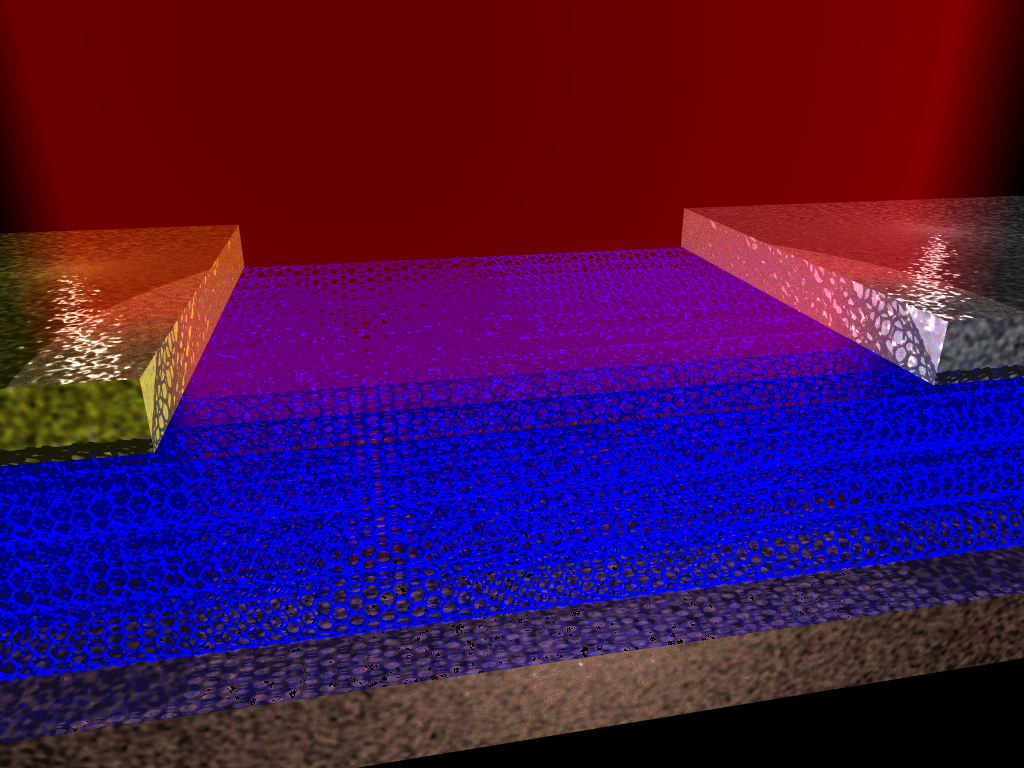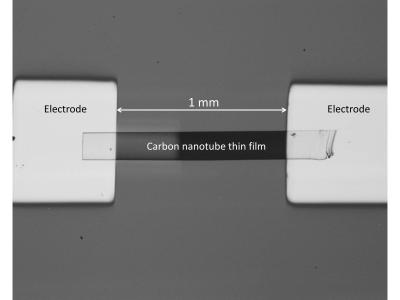Terahertz detectors using carbon nanotubes may lead to major imaging improvements
June 12, 2014

This illustration shows an array of parallel carbon nanotubes 300 micrometers long. Attached to electrodes, they show unique qualities as a photodetector (credit: Francois Leonard, Sandia National Laboratories)
Researchers at three institutions have teamed up to develop new terahertz detectors based on carbon nanotubes that could lead to significant improvements in medical imaging, airport passenger screening, food inspection, and other applications.
The research at Sandia National Laboratories, Rice University and the Tokyo Institute of Technology is described in a paper in Nano Letters journal. The technique uses carbon nanotubes to detect light in the terahertz frequency range without cooling.
“The photonic energy in the terahertz range is much smaller than for visible light, and we simply don’t have a lot of materials to absorb that light efficiently and convert it into an electronic signal,” said Sandia’s François Léonard, one of the authors..

New terahertz detector captures terahertz radiation using a carbon nanotube-based thin film contacted by two gold electrodes (credit: Rice University)
Eliminating the antenna
In 2008, Léonard authored The Physics of Carbon Nanotube Devices. He explained that terahertz radiation typically requires an antenna to achieve coupling into a single nanotube due to the relatively large size of terahertz waves.
The research team has now found a way to create a small detector that uses carbon-nanotube thin films without requiring an antenna, making the technique amenable to fabrication processes.
“Carbon nanotube thin films are extremely good absorbers of electromagnetic light,” Léonard explained. In the terahertz range, it turns out that thin films of these nanotubes will absorb all of the incoming terahertz radiation. Nanotube films have even been called “the blackest material” for their ability to absorb light effectively.
The researchers were able to wrap together several nanoscopic-sized tubes to create a macroscopic thin film that contains a mix of metallic and semiconducting carbon nanotubes.
“Trying to do that with a different kind of material would be nearly impossible, since a semiconductor and a metal couldn’t coexist at the nanoscale at high density,” explained co-author Junichiro Kono of Rice University.
The new technique, he said, combines the superb terahertz absorption properties of the metallic nanotubes and the unique electronic properties of the semiconducting carbon nanotubes. This allows for achieving a photodetector that does not require power to operate, with performance comparable to existing technology.
Applications in medicine, other areas
The new technique promises to take advantage of the many beneficial applications for terahertz radiation, said co-author Junichiro Kono of Rice University. Terahertz waves, for example, can easily penetrate fabric and other materials and could provide less-intrusive security screenings of people and cargo.
Terahertz imaging could also be used in food inspection without adversely impacting food quality. And it is as a potential replacement for magnetic resonance imaging (MRI) technology in screening for cancer and other diseases, using a hand-held terahertz detection camera that images tumors in real-time with pinpoint accuracy.
Next steps
The researchers plan to improve the design, engineering and performance of the terahertz detector next, Léonard said.
“For instance, they need to integrate an independent terahertz radiation source with the detector for applications that require a source.” The team also needs to incorporate electronics into the system and to further improve properties of the carbon nanotube material.
The project also received contributions from researchers taking part in NanoJapan, a 12-week summer program that enables freshman and sophomore physics and engineering students from U.S. universities to complete nanoscience research internships in Japan focused on terahertz nanoscience.
Researchers at Sandia National Laboratories, along with collaborators from Rice University and the Tokyo Institute of Technology, are developing new terahertz detectors based on carbon nanotubes that could lead to significant improvements in medical imaging, airport passenger screening, food inspection and other applications. Here, Sandia researcher François Léonard discusses the work.
Abstract of Nano Letters paper
Terahertz (THz) technologies are promising for diverse areas such as medicine, bioengineering, astronomy, environmental monitoring, and communications. However, despite decades of worldwide efforts, the THz region of the electromagnetic spectrum still continues to be elusive for solid state technology. Here, we report on the development of a powerless, compact, broadband, flexible, large-area, and polarization-sensitive carbon nanotube THz detector that works at room temperature. The detector is sensitive throughout the entire range of the THz technology gap, with responsivities as high as  2.5 V/W and polarization ratios as high as
2.5 V/W and polarization ratios as high as  5:1. Complete thermoelectric and opto-thermal characterization together unambiguously reveal the photothermoelectric origin of the THz photosignal, triggered by plasmonic absorption and collective antenna effects, and suggest that judicious design of thermal management and quantum engineering of Seebeck coefficients will lead to further enhancement of device performance.
5:1. Complete thermoelectric and opto-thermal characterization together unambiguously reveal the photothermoelectric origin of the THz photosignal, triggered by plasmonic absorption and collective antenna effects, and suggest that judicious design of thermal management and quantum engineering of Seebeck coefficients will lead to further enhancement of device performance.
Our next step, for instance, is to improve the design, engineering and performance of the terahertz detector. We need to integrate an independent terahertz radiation source with the detector for applications that require a source, and we also need to incorporate electronics into the system and to further improve properties of the carbon nanotube material. This will require additional research, funding, and perhaps even additional collaborators. Fortunately we have some very clear ideas about how we can achieve these technical goals, though new partnerships with industry or government agencies are welcome. All in all, it will likely be years still until we see this technology make its way into commercial use.